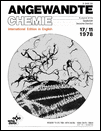Diorganodichlorophosphonium Hydrogen Dichlorides, a Novel Class of Compounds Containing [ClHCl]− Ions
Abstract
Stable salts of the dichlorohydrogenate ion are formed in the reaction shown below if R and/or R′ are p-methoxyphenyl groups. X-Ray structure analysis of (1), R′ = CH3, showed the two ClH bonds in the anion to be of different lengths. The only other known example, [Me4N]+[ClHCl]−, exhibits a similar asymmetry.





